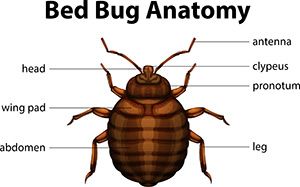Cookeville:
931-372-7676 | Crossville:
931-484-0085 | Sparta:
931-836-1131
Bed Bugs Treatments
It is extremely difficult to get rid of bed bugs. And do-it-yourself measures won't work at all. A professional pest control company will need to be involved. Call us to do a bed bug inspection and treatment options.
We will locate and treat the bed bugs and by using a combination of the most advanced products, apply Steam to infested areas. Future inspections and bed bug treatments may be necessary. Guarantee options including follow-ups are available.

Bed Bug Signs:
- Small brownish or reddish dots on bed linens or mattresses.
- Eggs and molted skins
- A "buggy", or sweetish smell
- Bed bug bites often result in red, itchy welts
Where Bed Bugs Hide:
- Mattresses, linens, and upholstery
- Furniture crevices
- Where floors & wood trim meet
- In and around electrical boxes & outlets
- Behind wallpaper and picture frames
How to Identify Bed Bugs
This insect probably received its common name of bed bug from its close association with human sleeping beds where it often seeks refuge during daylight, only to come out to feed on the beds occupant(s) at night. The bed bug is an ectoparasite of primarily humans but will also attack poultry, caged and invasive birds and various mammals, including rodents. It was introduced into the United States with the early colonists.
Bed Bug Detection
To detect bed bugs, you will need to inspect their habitat. Bed bugs harbor in cracks and crevices during the day and come out to feed at night. Typically, they can be found around mattress buttons and beading, in box springs or their coverings, and in any crevice of a wooden bed frame, such as where members join. Other places to check, to detect bed bugs, are wall hangings such as picture frames, nightstands, stuffed furniture, baseboards, floorboard cracks, behind loose wallpaper, light switches, door and window frames, conduits, etc. They will crawl considerable distances to obtain a blood meal.
-
City skyline
Photo By: John DoeButton
Bed Bug Identification
Bed bugs may be difficult to identify. Bed bugs are flat, wingless, and oval shaped (although young bed bugs can be too small for the naked eye to spot). They are often mistaken for ticks or small cockroaches. Distinguishing characteristics to identify bed bugs include:
- Mahogany to rust brown/red color
- Six Legs Short,
- Golden Body Hair
- Two antennae
Bed Bug Bites
Although the bite of bed bugs is painless, most people (80%) develop an allergic reaction to the saliva injected by the bug as it feeds. A swelling usually results from feeding but there is no red spot such as is characteristic with flea bites. Swelling from a bed bug bite may be severe and extend beyond the immediate bite area in highly sensitive individuals. Although bed bugs have been suspected in the transmission of many diseases or disease organisms in humans, in most cases conclusive evidence is lacking.
Bed bugs are small, brownish, flat insects, from no bigger than a pinhead, to the size of a tick in adults. They small ones cannot be seen by naked eye. They feed on the blood of animals, including humans. The name comes from their tendency to live between mattresses and feed on bed occupants at night. Bed bugs move quickly over floors, walls, and ceilings. Female bed bugs lay up to five eggs a day and can have 500 in a lifetime.
Bed Bug Prevention
You unknowingly bring bedbugs into your home after travel, mostly. To prevent bed bugs in your home, look for bedbug infestation in hotel rooms where you stay. If you find it, ask for another room on the other side of the hotel. Keep your suitcase off the floor if it’s open. You can encase your mattress and box springs in plastic covers, as is often done for asthma sufferers. This will kill trapped bedbugs within and prevent others from taking up homes there. Besides the characteristic obnoxiously sweet odor, the other primary clues to a bed bug infestation will be the presence of bed bugs and/or small red to reddish brown fecal spots here and there on surfaces.
Can They Be Them Eliminated? The answer is yes, it is possible to eliminate a bed bug infestation in most situations particularly if the bed bugs are detected shortly after they have been introduced into the environment. The longer bed bugs exist without being detected, the greater their opportunity to disperse within the environment, making it harder to find and eliminate 100% of the population. Another factor which plays a major role in how readily a bed bug infestation can be eliminated is the amount of available harborage for bed bugs to use as a haven from control efforts. Cluttered conditions, poorly sealed baseboards, crown moldings, window frames, door frames, paneling on walls, etc. offer virtually unlimited harborages.
Bed Bug Infestations:
Bed bugs are believed to have originally traveled to the United States from Europe in the 17th century. Efforts to control them after World War II dramatically reduced the occurrence of U.S. bed bug infestations. But recently, as you have heard in the news, bed bug infestations have made a big comeback. Six or seven years ago pest control companies in this area reported virtually no service calls a year. Now we get calls daily.
Bed Bugs are flat, wingless and oval shaped (although young bed bugs can be too small for the naked eye). They are often mistaken for ticks or small cockroaches. Distinguishing characteristics include:
Please break this into three columns and put an icon on top of each service.
Mahogany to rust brown/red color
Six Legs
Short, golden body hair
Two antennae
Have questions? Send us your queries and we’ll be in touch!



Quick Links
Contact Information
Address:
Serving Cookeville, Crossville and Sparta, TE.
PO Box 2871 Cookeville, Tennessee 38502-2871
United States
Email: blackrockservice@aim.com





